As healthcare institutions seek to continually increase the quality of care, incorporating artificial intelligence into their everyday practice through routine video capture and analysis will drive the greatest improvements, writes Theator CEO and co-founder Dr. Tamir Wolf.
For healthcare institutions across the globe, AI is rapidly becoming something much more than a buzzword: it’s now an integral part of their everyday operations.
As healthtech innovation accelerates and organizations seek to tap into AI’s power to streamline workflows, curb costs, and improve patient outcomes, 83% of executives in the industry have already developed an AI strategy, with another 15% planning to create one, according to the 2020 Optum Survey on AI in Healthcare.
To ensure the success of these strategies in surgical settings, organizations must prioritize routine video capture and analysis. Leveraging AI-enhanced video footage to analyze each procedure, providers can deliver vital advantages to all stakeholders in the surgical ecosystem: individual surgeons, department chairs, and hospital administrators. Patients will benefit from the refinement and scaling of surgical best practices informed by thousands of hours of OR footage.
While the hardware for video footage already exists in the form of laparoscopic cameras, a recent study of surgeons’ perspectives on routine video capture revealed that implementation has been far from consistent: many surgeons forget to start recording when they begin an operation, and others are unfamiliar with how to operate systems that store or transfer recordings. Moreover, once surgical video is captured, professionals must analyze hours of surgical footage to provide surgeons with digestible and valuable insights. As long as such hurdles persist, video capture will be sporadic, and its benefits will be too.
The good news is that these obstacles are far from insurmountable. Here’s what healthcare stakeholders should know about successfully utilizing video footage in surgical settings.
Video Capture A Powerful Aid to Surgeons
The core advantage of an automated surgical artificial intelligence platform is the combination of touchless routine video capture with automated AI-powered annotations to offer a seamless connection with clinical outcomes. Automation enables surgeons to link between what happens in surgery and surgical outcomes. Utilizing video analytics, surgeons can review past procedures, assess their decisions, and draw clearer connections between what happens in the OR and how those key surgical events impact patients thereafter – making a fundamental difference to the quality of care. Video data turns into rich, granular analytical insights, which in turn empower physicians to improve their workflows much more than they could relying only on their notes and memories.
Of course, making video capture the default rather than the exception is essential to unlocking these benefits. Automated capture is one effective way of achieving this as it both ensures the routine recording of surgical procedures and doesn’t disrupt surgeons’ workflows.
Transforming Surgical Departments
Equipped with automated video capture and analysis, surgical department chairs can boost department-wide visibility and gather cross-departmental insights on surgeons’ performance and how varying techniques can influence patient outcomes.
A centralized, department-wide database of surgical footage, enhanced with automated curations and advanced analyses would make it possible for departments to offer hyper-personalized care to each patient, while also better preparing the hospital for potential post-operative complications. Such a database would also be a boon to department chairs’ efforts to identify trends and reduce variation in surgical performances on an individual, department, or system-wide level. This approach allows for the quality assurance of surgical care on a large, data-driven scale.
System-Wide Innovation
Beyond individual surgeons and departments, video capture promises to aid hospital administrators and IT professionals in their efforts to manage risks and curb costs. For example, systems that utilize an intelligent platform will have a fully managed solution that eliminates the need to store additional video data themselves. Cloud-based systems have also been proven to be significantly more secure, which is paramount when it comes to protecting patient and clinical data.
Video libraries enhanced with AI-powered curation and analysis can significantly augment a surgeon’s ability to recognize and focus on the most crucial moments throughout different procedures: instead of requiring practitioners to watch hours and hours of unnecessary footage, these libraries offer annotated guides to best practices and quality assurance, all while saving money and time at the administrative level.
A Step Towards The Future of Surgery
By now, it’s abundantly clear that routine video capture will usher in a series of AI-powered, game-changing innovations across healthcare ecosystems. In the surgical realm, fulfilling AI’s promise starts with routine video capture – the tool which, for the first time, makes it possible to connect the dots between intraoperative events and patient outcomes and is an essential step on the path to real-time decision support in the near future. Routine video capture paves the way towards a wide range of tangible gains in surgery, risk assessment, OR efficiency and more, benefitting patients, surgeons, department chairs, and hospital administrators alike.
From lower costs to better outcomes and enhanced surgical training, the AI revolution in surgery is here – and while it may not be televised, it will most certainly unfold on video.
By Dr. Tamir Wolf, CEO and Co-Founder, Theator

